Все способы:
- «Журнал ошибок» в Виндовс 10
- Включение логирования
- Запуск «Просмотра событий»
- Анализ журнала ошибок
- Вопросы и ответы: 5
Во время работы операционной системы, как и любого другого программного обеспечения, периодически возникают ошибки. Очень важно уметь анализировать и исправлять подобные проблемы, дабы в будущем они не появлялись снова. В ОС Windows 10 для этого был внедрен специальный «Журнал ошибок». Именно о нем мы и поговорим в рамках данной статьи.
«Журнал ошибок» в Виндовс 10
Упомянутый ранее журнал является лишь небольшой частью системной утилиты «Просмотр событий», которая по умолчанию присутствует в каждой версии Windows 10. Далее мы разберем три важных аспекта, которые касаются «Журнала ошибок» — включение логирования, запуск средства «Просмотр событий» и анализ системных сообщений.
Включение логирования
Для того чтобы система могла записывать все события в журнал, необходимо включить его. Для этого выполните следующие действия:
- Нажмите в любом пустом месте «Панели задач» правой кнопкой мышки. Из контекстного меню выберите пункт «Диспетчер задач».
- В открывшемся окне перейдите во вкладку «Службы», а затем на самой странице в самом низу нажмите кнопку «Открыть службы».
- Далее в перечне служб нужно найти «Журнал событий Windows». Убедитесь, что она запущена и работает в автоматическом режиме. Об этом должны свидетельствовать надписи в графах «Состояние» и «Тип запуска».
- Если значение указанных строк отличается от тех, что вы видите на скриншоте выше, откройте окно редактора службы. Для этого кликните два раза левой кнопкой мыши на ее названии. Затем переключите «Тип запуска» в режим «Автоматически», и активируйте саму службу путем нажатия кнопки «Запустить». Для подтверждения нажмите «OK».


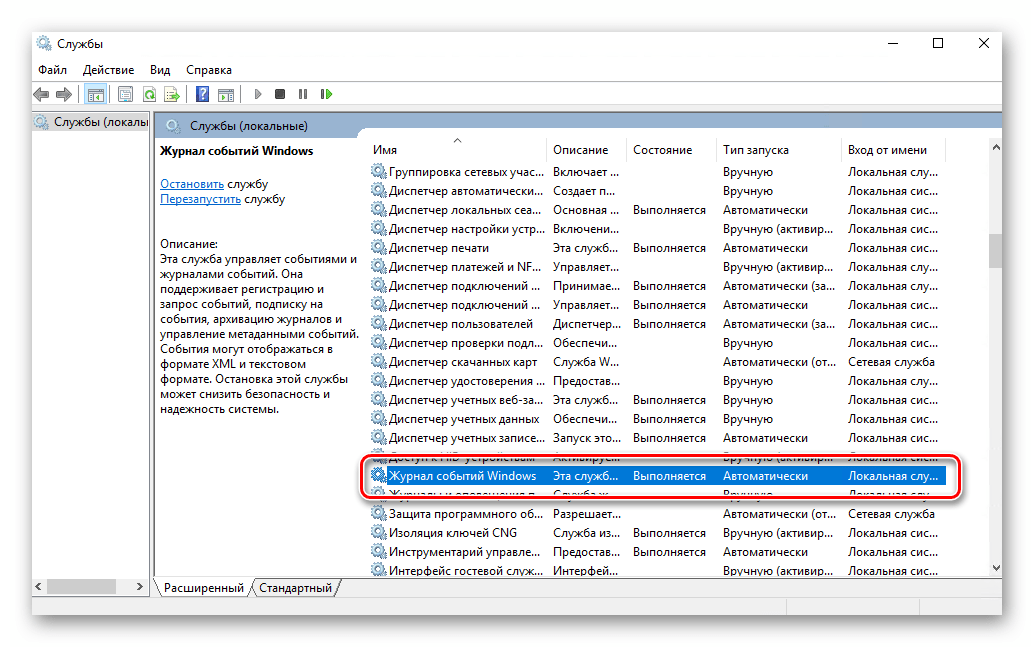
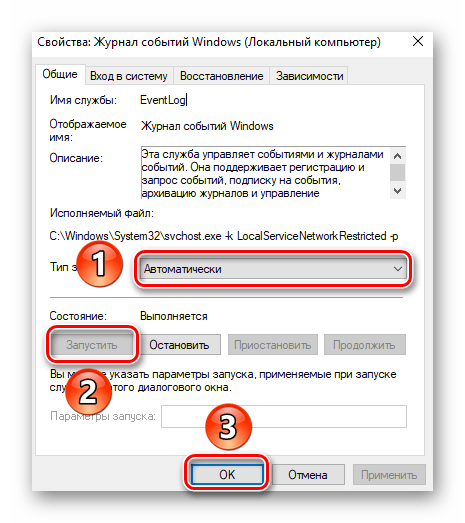
После этого остается проверить, активирован ли на компьютере файл подкачки. Дело в том, что при его выключении система попросту не сможет вести учет всех событий. Поэтому очень важно установить значение виртуальной памяти хотя бы 200 Мб. Об этом напоминает сама Windows 10 в сообщении, которое возникает при полной деактивации файла подкачки.
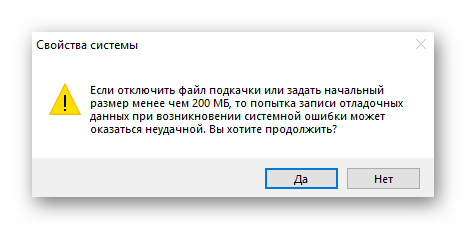
О том, как задействовать виртуальную память и изменить ее размер, мы уже писали ранее в отдельной статье. Ознакомьтесь с ней при необходимости.
Подробнее: Включение файла подкачки на компьютере с Windows 10
С включением логирования разобрались. Теперь двигаемся дальше.
Запуск «Просмотра событий»
Как мы уже упоминали ранее, «Журнал ошибок» входит в состав стандартной оснастки «Просмотр событий». Запустить ее очень просто. Делается это следующим образом:
- Нажмите на клавиатуре одновременно клавишу «Windows» и «R».
- В строку открывшегося окна введите
eventvwr.mscи нажмите «Enter» либо же кнопку «OK» ниже.
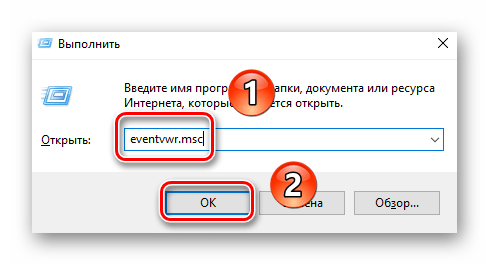
В результате на экране появится главное окно упомянутой утилиты. Обратите внимание, что существуют и другие методы, которые позволяют запустить «Просмотр событий». О них мы в деталях рассказывали ранее в отдельной статье.
Подробнее: Просмотр журнала событий в ОС Windows 10
Анализ журнала ошибок
После того как «Просмотр событий» будет запущен, вы увидите на экране следующее окно.
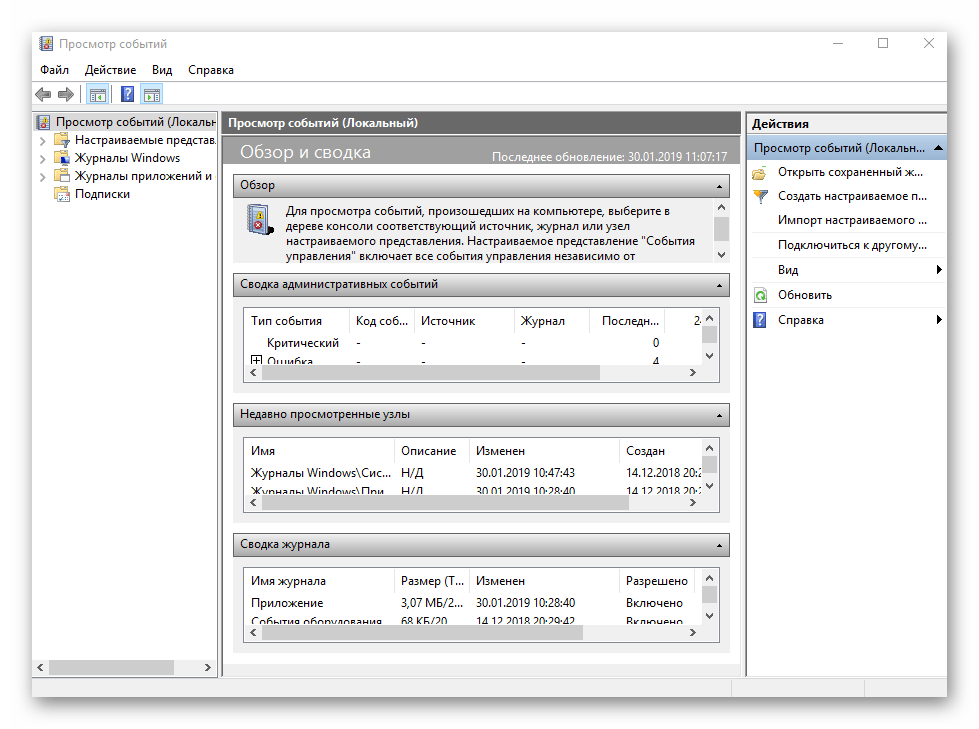
В левой его части находится древовидная система с разделами. Нас интересует вкладка «Журналы Windows». Нажмите на ее названии один раз ЛКМ. В результате вы увидите список вложенных подразделов и общую статистику в центральной части окна.
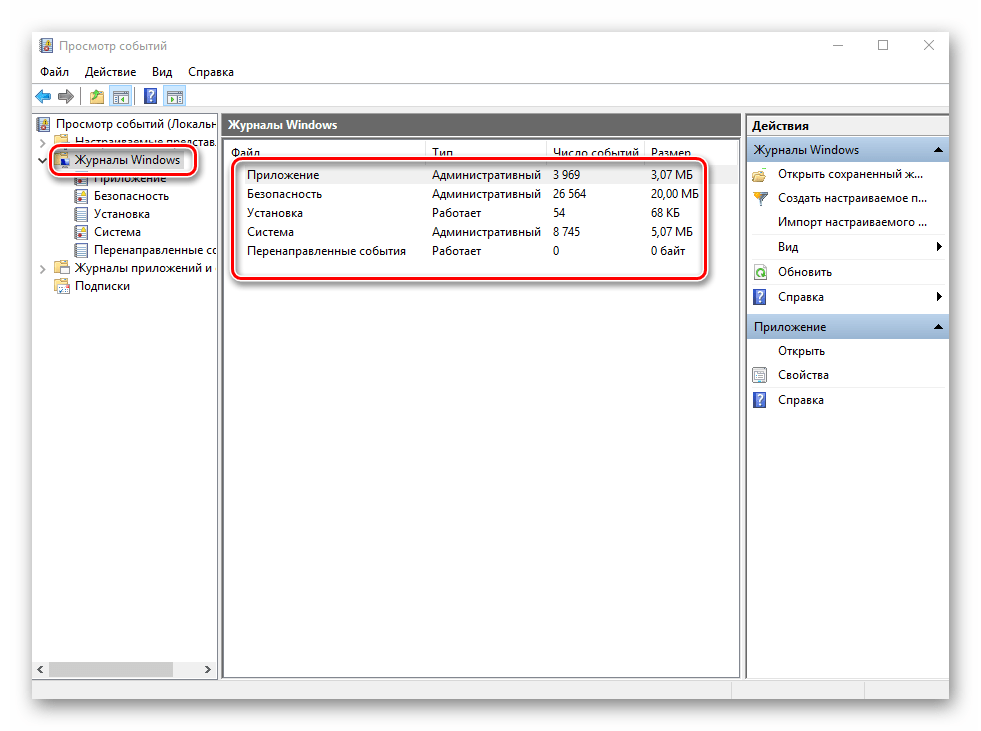
Для дальнейшего анализа необходимо зайти в подраздел «Система». В нем находится большой список событий, которые ранее происходили на компьютере. Всего можно выделить четыре типа событий: критическое, ошибка, предупреждение и сведения. Мы вкратце расскажем вам о каждом из них. Обратите внимание, что описать все возможные ошибки мы не можем просто физически. Их много и все они зависят от различных факторов. Поэтому если у вас не получится что-то решить самостоятельно, можете описать проблему в комментариях.
Критическое событие
Данное событие помечено в журнале красным кругом с крестиком внутри и соответствующей припиской. Кликнув по названию такой ошибки из списка, немного ниже вы сможете увидеть общие сведения происшествия.
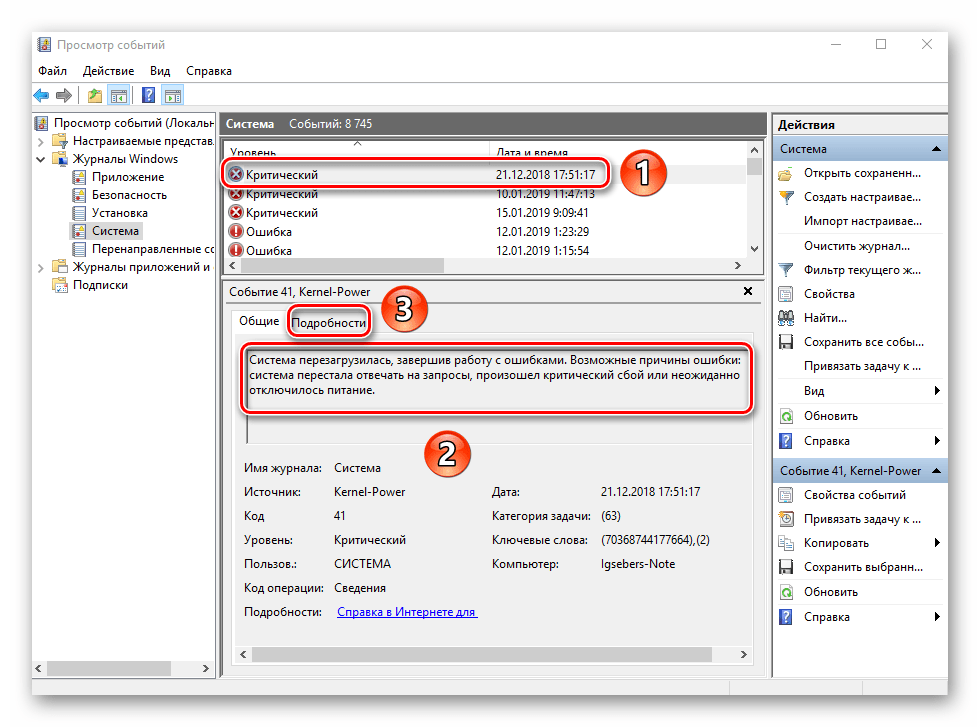
Зачастую представленной информации достаточно для того, чтобы найти решение проблемы. В данном примере система сообщает о том, что компьютер был резко выключен. Для того чтобы ошибка не появлялась вновь, достаточно просто корректно выключать ПК.
Подробнее: Выключение системы Windows 10
Для более продвинутого пользователя есть специальная вкладка «Подробности», где все событие представлены с кодами ошибок и последовательно расписаны.
Ошибка
Этот тип событий второй по важности. Каждая ошибка помечена в журнале красным кругом с восклицательным знаком. Как и в случае с критическим событием, достаточно нажать ЛКМ по названию ошибки для просмотра подробностей.
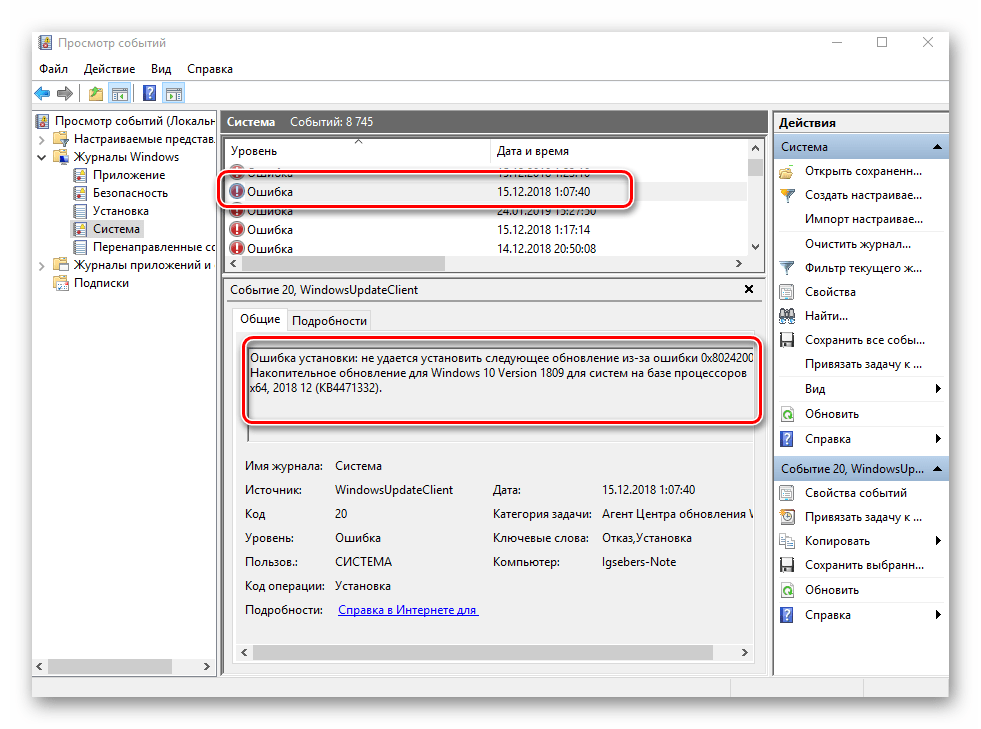
Если из сообщения в поле «Общие» вы ничего не поняли, можно попробовать найти информацию об ошибке в сети. Для этого используйте название источника и код события. Они указаны в соответствующих графах напротив названия самой ошибки. Для решения проблемы в нашем случае необходимо попросту повторно инсталлировать обновление с нужным номером.
Подробнее: Устанавливаем обновления для Windows 10 вручную
Предупреждение
Сообщения данного типа возникают в тех ситуациях, когда проблема не носит серьезный характер. В большинстве случаев их можно игнорировать, но если событие повторяется раз за разом, стоит уделить ему внимание.
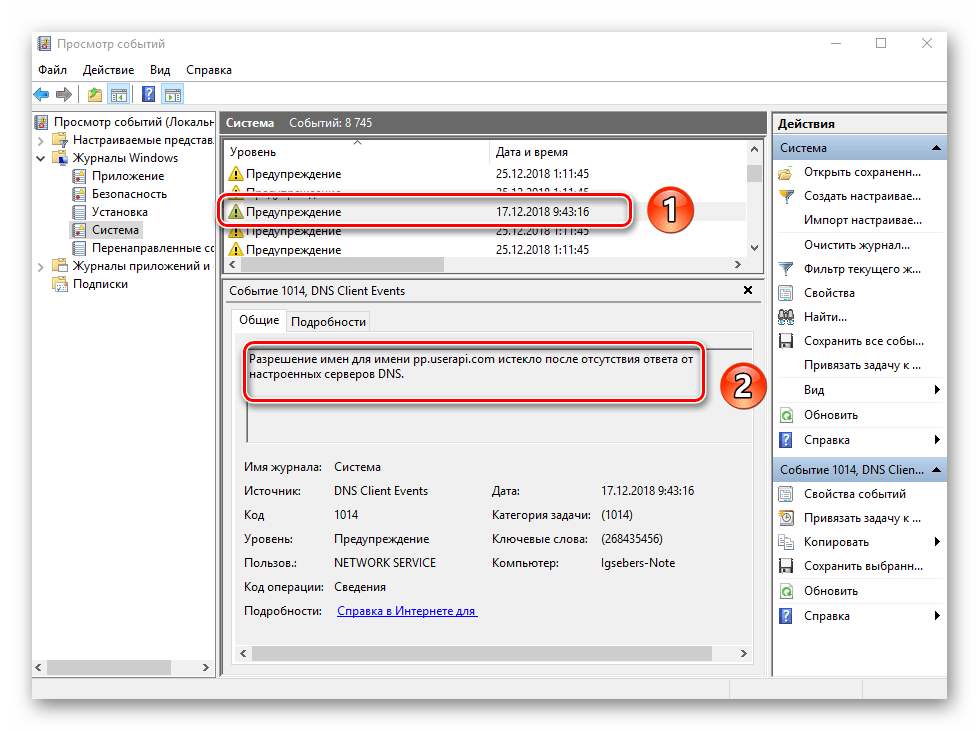
Чаще всего причиной появления предупреждения служит DNS-сервер, вернее, неудачная попытка какой-либо программы подключиться к нему. В таких ситуациях софт или утилита попросту обращается к запасному адресу.
Сведения
Этот тип событий самый безобидный и создан лишь для того, чтобы вы могли быть в курсе всего происходящего. Как понятно из его названия, в сообщение содержатся сводные данные о всех инсталлированных обновлениях и программах, созданных точках восстановления и т.д.
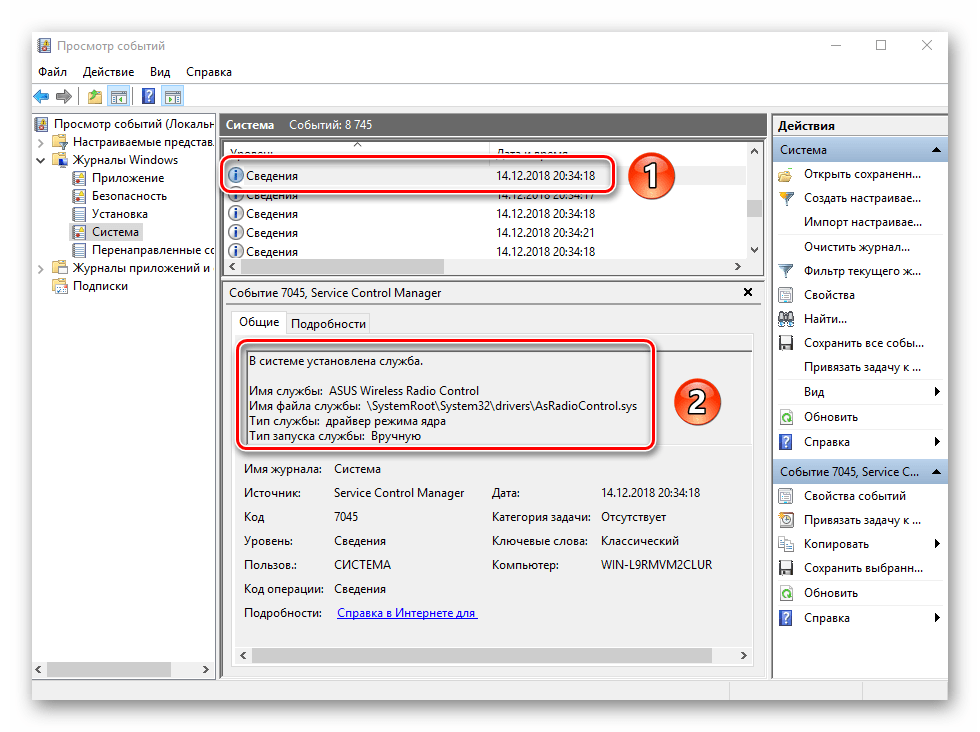
Подобная информация будет очень кстати для тех пользователей, которые не хотят устанавливать сторонний софт для просмотра последних действий Windows 10.
Как видите, процесс активации, запуска и анализа журнала ошибок очень прост и не требует от вас глубоких познаний ПК. Помните, что таким образом можно узнать информацию не только о системе, но и о других ее компонентах. Для этого достаточно в утилите «Просмотр событий» выбрать другой раздел.
Наша группа в TelegramПолезные советы и помощь
Has your computer with Windows 10 operating system just crashed suddenly and you are right now searching for a way to view crash logs in Windows 10 then you have come to the right place. This is where we can guide you on how you can check crash logs in Windows 10.

Table of Contents
Windows crash may be because of a lot of reasons like overheating of the system or some fault in the driver installed. This is where the crash logs option comes in use for you can see what has caused the crash and other info like the name of the log and the EventID.
What Causes Windows 10 to Crash?
The users that face this kind of crash the first time may think that the reason behind this might be confusing and it will not be worth it to know. But the point to focus on here is the fault might not be with the components of Windows 10 and there must be an external reason that you can check in Windows crash report.
- Issue in RAM: There is a high possibility that your computer RAM is not working at the optimum level and that is what causes your PC trouble in retrieving data from memory whensoever you are trying to do so.
- Overheated System: With low RAM size or any other compatibility issue in the motherboard you may face an overheating of the system that is causing your PC to crash or freeze.
- Incompatible Driver: It is a common habit to install new drivers for our system when our pre-installed drivers get outdated and start to make any function of the PC lag. But these drivers may in all possibility contain some viruses or bugs that can potentially harm and cause our system to crash.
- Issue with Hard Drive: Hard drives contain most of the data in your PC and any fault can create a situation that most probably will lead to a crash where a Windows 10 blue screen log is.
Microsoft’s investigation identifies the following as the primary reasons why Windows crashes:
- 70% of accidents are the result of rogue driver code.
- 10% of the total is accounted for by hardware issues.
- 15% of the cases include unknown causes.
- 5% of the issues are the result of Microsoft code.
You can check our guide to Fix Windows 10 Crashing Randomly.
Here, we have listed the ways to check crash logs in Windows 10.
Method 1: Through Event Viewer
Event viewer is an inbuilt app to view crash logs in Windows 10. You may view the event logs on your computer using the Event Viewer component of the Windows operating system. Application and system messages, such as informative messages, errors, warnings, etc., are logged by Event Viewer. You may identify the specific reasons why your computer crashes using Event Viewer and it is one of the easiest ways to get Windows crash reports.
1. Go to the Windows Cortana Search box and type Event Viewer. Click on Open.

2. Click on Windows log. This is where you will get all logs including Windows 10 blue screen log.

3. Then, choose System from the drop-down menu.

4. On the event list, click Error. Then you can view all the information about Windows crash reports.

Also Read: How to Clear All Event Logs in Event Viewer in Windows 10
Method 2: Through Reliability Monitor
There is another tool to get reliable information and view crash logs in Windows 10. It is called a Reliability Monitor and as the name suggests, it is a great choice to depend on in case your Windows 10 PC crashes. Below are the steps that will help you guide on how to use this to check crash logs in Windows 10.
1. Again, go to Windows 10 Cortana search box and type Reliability Monitor, and click on Open.

2. You will see on the interface Reliability Monitor is generating the report Please wait.

3. You will see Stability Index.

It assesses your overall system stability on a scale from 1 to 10. You can select any week or any day to review specific hardware or software problems that troubled your system. The horizontal line in blue will show you the score.
Note: stability index does not take into account warning and informational events when it calculates the stability score from 1 to 10.
The report records 3 failures which are application failure, Windows failure, and miscellaneous failure. Moreover, it records informational events and warnings. The table below shows how these failures, informational events, and warnings.
| Icon | Information it shows |
| Blue info icon | Informational events |
| Red cross icon | 3 failures |
| Yellow exclamation icon | Warning |
4. Then out of all these crash dates if you want any information about a particular date what you got to do is just, click on that date’s column. This will open a new window displaying all the information.

5. Click on View all problem reports.

Now, you will see all crash log details.

Also Read: Fix The Procedure Entry Point Error on Windows
Method 3: Through Windows PowerShell
Third and the final method to check cash logs in Windows 10 is using the Power Shell tool. Power Shell is a great application that is used in automating the management system with the use of a scripting language. Read below to understand how you can use this application to view crash logs in Windows 10.
1. Go to the Windows 10 Cortana search box and type PowerShell. Click on Open after finding the top search result.

2. Type the following command into the command box. The crash logs will be retrieved together with their Index, Time, EntryType, Source, InstanceID, and Description using this command.
Get-EventLog -Log system | where {$_.entryType -match "Error"}

3. Get the most recent crash logs up to the specified number by using the Newest argument. Run the following command to collect the 20 most recent crash logs:
Get-EventLog -LogName System -Newest 20 -EntryType Error

Frequently Asked Questions (FAQs)
Q1. Where do I find information about my computer crashing?
Ans. You can use Event viewer which is an in-built app in Windows 10, you can also use reliability monitor which is a user-friendly application and you can also use PowerShell application which is an open-source CLI tool.
Q2. What are the most frequent crashes in Windows 10?
Ans. The three most frequent crashes in Windows OS are fault at the application level, the software hangs unexpected restart and shutdown. There are other reasons also but these are common reasons as per Microsoft investigation.
Q3. Where can I find crash log in Windows 11?
Ans. You can use Event Viewer to see the crash logs in Windows 11. In the event viewer app, move to the Windows log. Then search error and tap on the error. Detailed information will be shown for the error.
Q4. Why does my PC keep crashing and freezing?
Ans. There are a number of reasons for crashes and freezing. Some common reasons are overheating, issues with memory, faulty hardware and software, malicious files, corrupted system registry files, and too little available memory.
Recommended:
- Fix Windows Does Not Have Enough Information to Verify This Certificate Solutions
- Why is my Computer Making Funny Noises?
- Fix Hard Disk Problems in Windows 10
- Fix Event 1000 Application Error in Windows 10
The Windows PCs are designed in a way that they can store all the crash log information in your crash log so you can at any time view crash log information in Windows 10. We hope that these methods might have helped you to view crash logs in Windows 10.
Readers help support Windows Report. We may get a commission if you buy through our links.
Read our disclosure page to find out how can you help Windows Report sustain the editorial team. Read more
If you are an advanced Windows user and want to know full details about a variety of events, including account logon and logoff activity, system information, warnings, etc., then you need to view the Microsoft Windows Event Viewer logs.
In this guide, we will explain to you all the steps that you need to understand how you can take a Windows event log backup and export the Windows event log on your PC. Let us check out the guide.
What is Microsoft Windows Event Viewer? With the Microsoft Windows Event Viewer, you can view a log of all application and system messages. These messages will include error information, warnings, account login/logoff information, etc.
How do I open Windows Event Viewer? Just type event viewer in the Search bar and select the Event Viewer app from the results.
You may also open Event Viewer by right-clicking the Windows button and selecting it from the context menu, or by typing eventvwr.msc into a Run console and press Enter.
This works on all the latest and previous versions of Windows OS. Let us now learn how you can perform Windows Event Viewer backup and export functions in the below segment.
How do I export or backup Windows Event log?
1. Export logs to CSV file
- Press the Win key to open the Start menu.
- Type Event Viewer and open the appropriate result.
- Expand the Windows logs section.
- Select the type of log you wish to be exported.
- On the right side of the log to be exported, select Save all Events as… option.
- In the Save as type drop-down select CSV (Comma Separated Value) (*CSV).
- In the File name box, type the name of the file and save it in your preferred location.
- Hit the Save button.
You can open this CSV file with Microsoft Excel and then troubleshoot the issues based on the information that you obtained from the Windows Event viewer.
- Microsoft Office Lens: A Powerful Tool for Capturing and Organizing Information
- Swap Left/Right Speaker in Realtek Audio Console [How to]
- How to Get DirectX 12 End-User Runtime and Fix Installation Issues
- Overclocking in OMEN Gaming Hub: How to Use it
- How to Disable Overlay in Razer Cortex: Hide in-game Overlay
2. Export as EVTX
- Press the Win key to open the Start menu.
- Type Event Viewer and open the appropriate result.
- Expand the Windows logs section.
- Select the type of log you wish to be exported.
- On the right side of the log to be exported, select Save all Events as… option.
- In the Save as type drop-down select Event Files (*.evtx).
- In the File name box, type the name of the file and save it in your preferred location.
- Hit the Save button.
When you perform the above steps, it will backup the Windows Event Viewer log file in .evtx format and also create a folder called LocaleMetaData in the destination where you have saved the log file.
How can I open the CSV file in MS Excel and sort events by ID?
- Launch Microsoft Excel.
- Open the CSV file on it.
- Choose Delimited on the first page of the Text Import Wizard.
- Hit the Next button.
- Select Comma and uncheck the Tab under the Delimiters option and click OK.
- Under the Column data format box select General and select Finish to view the Windows Event Viewer log in MS Excel.
- Click on the Event ID column to highlight the entire Event IDs.
- Hit Data from the menu options.
- Select Sort from the Data menu tab and select Expand the selection in the warning prompt that appears and click on Sort.
- In the Sort by drop-down, select Event ID and specify the sort order available under the Order drop-down and click OK.
Following the above steps, you can easily back up and view the Windows Event Viewer log file sorted in the order of Event IDs. This will help you locate the problem that you are looking to troubleshoot quicker.
That is it from us in this guide. We have a guide that lists down some of the best Windows Event Log Viewer tools and also detailed steps on how you can use them.
Several users have asked about what is Event ID 4656: A Handle to an Object was Requested error and how they fix it. You can learn about it in our dedicated guide.
Moreover, you can also check out the solutions to quickly resolve Event ID 4103. For more information on Event ID 800, we would suggest you apply the fixes mentioned in our guide to resolve it at your end.
Feel free to drop a comment below and let us know if you understood without any issues regarding how to backup the Windows log event on your computer.
Sagar Naresh
Sagar is a web developer and technology journalist. Currently associated with WindowsReport and SamMobile. When not writing, he is either at the gym sweating it out or playing country music on his guitar.
He is an avid traveler and has been to 15 countries, going to more places soon. TRAVEL and WORK is his mantra for a peaceful life.
Table of Contents
- Find Windows 10 / 11 Errors Logs Using Event Viewer
- Find Windows 10 / 11 Errors Log Using Powershell
- Find Windows 10 / 11 Crashes and Error Logs using Reliability Monitor
- Find Windows 10 / 11 crashes log with the help of Windows Memory Dump File
- Find Windows 10 / 11 Crashes and Error Logs using Third-Party Software
- How to Fix Crash in Windows 10 and Windows 11?
macOS, Linux, and Windows OS are the three operating systems that have the most number of users worldwide. If you want to know which operating system crashes the most, you should ask any tech nerd. Then everyone will say that there is no operating system that does not crash, but the Windows operating system has the most crashes, freezes, and hangs out of all operating systems.
There are several potential causes of a computer crash, some of which are flaws with the hardware, some with the operating system, and still others with software. Some of the popular and well-known issues are :
1 Virus and malware.
2 Corrupted OS and third party Software
3 Outdated and Corrupted Drivers.
4 Insufficient and low capacity hardware resources like CPU, RAM, and Harddisk.
5 Overheating Systems, Faulty Manufacturing.
6 InCompatible Software
7 Unreliable or unstable source of power supply
Actually finding errors and troubleshooting errors is a difficult task. Instead of doing random things from random advice which may be poorly stated the problem, the best solution is to try and read this blog thoroughly which helps you to understand the problem and solve it accordingly.
One thing to note is that finding and fixing crashes may take time. Some can be fixed soon and some may take days. These steps mentioned here help in identifying and narrowing down the problem that you are facing with your pc.
Find Windows 10 / 11 Errors Logs Using Event Viewer
When your hardware or software of the system crashes, hangs, or freezes then the operating system generates and maintains a crash log record to identify the causes of the crashes. Windows Operating System maintains this log-in Event Viewer.
Event Viewer captures all the information like how your system software and drivers are loaded. That captured information can be of various types like errors types, informational types, warning types, success audit types, alert types, notice types, and debug types failure audit types. Though there are a large amount of data in logs, our mission should be to find and filter specific problem.
Event Severity Types:
There are mainly 3 event severity types: Information, Warning, and Error.
Informational: It indicates successful action performed in your system. Like progress status messages, success messages, informational messages, etc.
Warning: It indicates information that might create problems in the future.
Error: It indicates problems like failures of critical tasks.
Follow the below steps for finding errors in Event Viewer.
1 Goto search bar and type event and select Event Viewer from the list.

Event Viewer will be opened up as shown below.

As soon as you opened the event viewer, you will get a summary of Administrative Events which provides various event type information as shown below.
Here, we can see, that within 7 days, 142 Error Levels are detected, 9 within 24 hours, and 2 within the last hour.
Similarly, you can find other event types like a warning, informational, and audit success information.
For finding out error and crashes log information, we will focus on two logs.
- Windows Logs
- Applications and Services Logs

Now, let’s find out the simple errors.
2 Under Windows Logs, click on System. Then on the main panel, you will find all the log information. Scroll down in the main panel, you will find the Error Level log as shown below.
It provides information like when was this error recorded, its Event Id, Task Category, Source from where the error occurs, etc. When you click on the error you will get general and detailed information about the error.

General Tab shows general information.
Detail Tab shows raw event data and you can view those data in Friendly View as well as XML View.
Create Custom View of Error Logs
We can create and filter the custom views of the logs so that we can view only a particular level.
1 Click on Create Custom View located at the top-right pane as shown below.

2 Select Error from Event Level and under Event Logs dropdown select Windows Logs > System and press Ok.

Here, I am filtering Error Level for System Category.
3 Give a name for Custom View. Here I have given «Windows System Error Logs» as shown below.

4 Those custom views are recorded under the Custom Views folder located at the top left pane.
As I have just created a «Windows System Error Logs» custom view, click on it. And we will get all error which is present under Windows Log > System.
We can easily archive those error and crashes in various format like .evt, .txt, .csv etc.
Find Windows 10 / 11 Errors Log Using Powershell
Powershell is a powerful Microsoft tool that provides a command-line interface for task automation and configuration management framework.
Let’s find out error logs using Powershell.
Syntax:
Get-EventLog -Log LogName | where {$_.entryType -match «LogType«}
Eg. Finding Error Level Log from Windows System records related to programs installed on the system.
Get-EventLog -Log system | where {$_.entryType -match «Error«}

or simply
Get-EventLog -LogName System -EntryType Error
Now,
let’s get the newest 15 error log from System Event.
Get-EventLog -LogName System -Newest 15 -EntryType Error

Here, instead of 15, you can use any number.
Find Windows 10 / 11 Crashes and Error Logs using Reliability Monitor
Windows 7 introduced Reliability Monitor features and later adopted them in Windows 8,8.1,10 and 11. Reliability Monitor gives a quick overview of how your system is. It describes errors, warnings, and crash information in graphical format in a much more readable way. Overall, Reliability Monitor tells about how reliable and stable your system has been.
So, let’s find Windows 10 crashes and error logs using Reliability Monitor.
1 Goto search bar and type reliability and then select «view reliability history» from the list.

Reliability Monitor looks like this:

It has a stability Score ranging from one to ten. And, according to your system, its score changes on a regular basis. The horizontal line in the figure above clearly shows that on 5/24/2021, the stability index is around 5, and the system was performing well up to 6/2/2021. The stability score then fell on 6/3/2021.
It has 4 different categories. As shown in the right red rectangle above.
- Application Failures: These tracks like unexpectedly closed the application, applications not responding information, etc.
- Windows Failures: This tracks Operating system failed to start, OS crashes, driver failure, etc.
- Miscellaneous Failures: Other failures not included in application and windows failures.
- Warnings: such as Unable to update windows etc.
- Information: such as Successful windows update.
Here in the chart, critical Errors are shown by red circles, warnings are shown by yellow triangles, and information is shown in blue circles. Note that: Warning and information are not taken while calculating the stability index.
In the graph, we can see that the first error took place on 5/24/2021, as indicated by the red X circle. This error is connected to application failures, as the graph shows. On June 5th, 2021, we can see that problems and faults relating to applications and windows have happened. On the same day, we can also see that warnings and informational messages have been displayed.
When you click on any row in the chart, you will get respective date failures(if any)/warning(if any)/information(if any) just below the chart.
When clicked on the row of date: 6/3/2021, those errors are shown as below. Here we can clearly see that system is having critical errors as Windows Hardware errors and Asus System Analysis Stopped working error. Also, it is showing Windows Update failure warning and Windows.
Find Windows 10 / 11 crashes log with the help of the Windows Memory Dump File
If your Windows system crashes and you want to record the issue and prevent/troubleshoot it from happening again, a Windows Memory dump file may be useful. It helps in the recovery of information from a crashed computer. It contains an error message associated with a blue-screen of death(BSOD). (Tested in Both Windows 10 and Windows 11)
If your system is currently running, enable a memory dump to collect memory dumps if the freeze issue occurs again.
1 Goto run and type: sysdm.cpl and press enter.

2 Click on the Advance tab
3 Under the Startup and Recovery section, click on Settings.

4 Then Check «Write an event to the system log» and uncheck «Automatically restart»
5 Select «Complete Memory Dump» if you have a large disk size otherwise select a Small memory dump(256 KB) if you have limited disk space.
6 Select «Overwrite any existing file» to overwrite the existing file.

7 Click on the Ok button.
Now when your system crashes and you want to find crashed information then you will get it at path «%SystemRoot%\MEMORY.DMP»
Note: To create a memory dump file, Windows requires at least a 2 MB paging file on the boot volume.

Find Windows 10 / 11 Crashes and Error Logs using Third-Party Software
There are lots of Windows 10 / 11 Event Logs third-party software which can be handy for you. So here is the list of some commonly used Windows 10 Event Logs Viewer for Finding Crashes and Error Logs
1 SysMon
Sysmon (System Monitor) is a component of SysInternals Tools. It is a Windows system service and device driver. Once installed, it remains resident across system reboots to monitor and log system activity to the Windows event log. It provides detailed information on what is happening in the operating system, such as process creation, network connections, and changes to file creation time.
Download
2 Splunk
Splunk Cloud Platform can be used to monitor Windows Event Log channels. Splunk universal or heavy forwarder is utilized here to collect data and send it to Splunk Cloud Platforms.

Download
3 Event Log Explorer
Event Log Explorer is a powerful software tool that allows you to observe, analyze, and monitor Windows Event Log activities. Event Log Explorer significantly simplifies and accelerates event log examination of all types, including security, system, application, setup, DNS, and others.
Download
4 LOGalyze
Logalyze is open-source software that is free and lightweight for centralized log management and network monitoring.LOGalyze can analyze server and application logs and can report data in PDF, CSV, and HTML format. It is compatible with both Linux and Windows operating systems.
It also offers powerful search capabilities and can detect real-time events in services distributed across multiple nodes.

Download
5 SnakeTail
SnakeTail is another Windows Tail log analyzer tool for monitoring large text files and Windows Event Logs with no administrative rights.
Download
How to Fix Crash in Windows 10 and Windows 11?
You can fix or reduce the crashing issue on Windows 10 or 11 by following the steps below.
1 Reboot your PC: It’s possible that simply restarting your computer will solve the problem. It will clean the memory and put a stop to any processes that are hogging your resources, such as RAM and CPU, for no apparent reason. A reboot can fix problems with hardware and peripheral devices as well.
2 Disable CPU Overclocking: There are situations when your CPU will crash due to overheating, and the overheating could be caused by an overclocked CPU. Stopping the CPU from being overclocked is therefore one technique to prevent the overheating and crashing issue.
3 Updates Driver from Guenine Source: Keeping your drivers up to date and updating those that are out of date can prevent your computer from crashing.
An obsolete driver or missing updates or corrupted updates could be responsible for a BSOD that prevents you from accessing the desktop.
If you experience crashes in your programs, such as Zoom, Skype, and games, then you probably blame this application; however, this does not always happen, and the problem could be with your driver; thus, you should update your driver as soon as you can.
4 System Restore: If you are having issues with the functionality of your Windows machine, you can use the System Restore feature to revert the system files, program files, and registry information to an earlier version themselves. If these files are damaged or corrupted in any way, using System Restore to restore them to an earlier point in time will fix the issue for you.
5 Scan your system for the error
You can try any of the below commands to scan your system.
sfc /scannow
When you use the command sfc /scannow, it will check all of the protected system files and, if any of them are corrupted, it will replace them with a cached duplicate that is stored in a compressed folder at the path %WinDir%\System32\dllcache
You can try DISM Command: The Dism command does a check for corruption and fixes any issues that it discovers with the operating system into which you are currently logged.
dism.exe /online /cleanup-image /restorehealth
FAQ:
1 What are the most common crashes in Windows OS?
Ans: Almost all the crashes and error logs of windows OS can be found in Event Viewer. Event Log can tell you why and when a crash occurred.
There are 3 most common crashes in Windows OS are :
- Unexpected Shutdown and restart.
- Application Hangs
- Application Level Fault.
2 Where to find startup problems?
Ans: You can find boot/startup logs in Event Viewer, Reliability Monitor, and Boot Logs.
You can look above for the Event Viewer method and reliability monitor methods. Here I will explain using Boot Logs. Actually, Boot Logs contains both Successful as well as unsuccessful information that occurs during boot. Those logs are found in the Ntbtlog.txt file.
3 What is BSOD?
BSOD stands for Blue Screen Of Death. As a name, they are a kind of fatal windows system crash displayed in Blue Screen as shown below.

BSOD signifies a system crash in which the operating system is unable to operate safely. The General Cause of BSOD is hardware and software driver issues.
4 How to fix Windows Corrupted System Files?
If there are corrupted system files in Windows, then SRC(System File Checker) can fix most of them.
- Open Command Prompt with admin privileges.
- Type the below command and press Enter
sfc /scannow
Then wait for the process to complete.
Can I Clear Error Log in Windows 11 ?
Ans: You are free to go. Windows Error Logs are small in size and can be left as it is. You should not be concerned about them at all.You are free to clear them if you wish.











